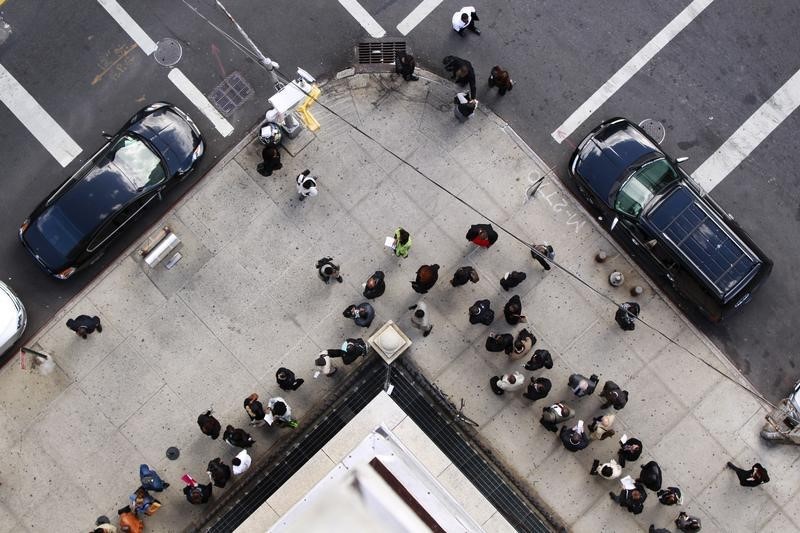By Lucia Mutikani
WASHINGTON (Reuters) - U.S. job growth rebounded last month and the unemployment rate dropped to a near seven-year low of 5.4 percent, signs of a pick-up in economic momentum that could keep the Federal Reserve on track to hike interest rates this year.
Nonfarm payrolls increased 223,000 as gains in services sector and construction jobs offset weakness in mining, the Labor Department said on Friday. The one-tenth of a percentage point decline in the unemployment rate to its lowest level since May 2008 came even as more people piled into the labour market.
While the report suggested underlying strength in the economy at the start of the second quarter after a bad stumble, wage growth was tepid and March payrolls were revised downward, leading financial markets to push back rate hike bets.
"We see this report as reducing concerns that weak first-quarter growth represents a loss of economic momentum," said Michael Gapen, chief U.S. economist at Barclays (LONDON:BARC) in New York.
Nevertheless, he said the bounce back was not strong enough to think the Fed could bump rates higher before September.
March payrolls were revised to show only 85,000 jobs created, the fewest since June 2012. That resulted in 39,000 fewer jobs added in February and March than previously reported, underscoring the weakness in activity at the start of the year.
Investors on Wall Street cheered the report, with major stock indexes rising more than 1 percent.
Yields on U.S. Treasury debt slipped and futures contracts showed traders clinging to bets the U.S. central bank would raise rates from near zero this year. The dollar was little changed against a basket of currencies.
LABOUR MARKET TIGHTENING
The drop in the unemployment rate pushed it within a whisker or two of the 5.0 percent to 5.2 percent range that most Fed officials consider consistent with full employment.
Some economists said the tightening labour market could push Fed officials to tighten monetary policy despite anaemic wage growth.
"Even without wages or inflation picking up, we do not think the Fed will feel comfortable sitting at zero as the unemployment rate closes in on 5 percent," said Michelle Girard, chief economist at RBS (LONDON:RBS) in Stamford, Connecticut.Also encouraging, the labour force participation rate, or the share of working-age Americans who are employed or at least looking for a job, rose 0.1 percentage point to 62.8 percent, although that was just up from a 36-year low.
Other measures on the Fed's so-called dashboard also improved further.
A broad measure of joblessness that includes people who want to work but have given up searching and those working part-time because they cannot find full-time employment fell to 10.8 percent - the lowest level since August 2008.
In addition, the number of long-term unemployed continued to fall.
Wages, however, were a weak spot. Average hourly earnings rose just three cents in April. While that took the year-on-year gain to 2.2 percent, it remained stuck in the range it has been in for the past few years.
The weakness in average hourly earnings is in stark contrast with other compensation measures that have suggested solid wage growth in recent months.
"With the unemployment rate approaching full-employment levels it will only be a matter of time before wages start to rise at a somewhat swifter pace," said Scott Anderson, chief economist at Bank of the West in San Francisco.
Last month, the government reported that the economy expanded at only a 0.2 percent annual rate in the first quarter, but data earlier this week showing a wider-than-forecast trade deficit suggests GDP actually shrank.
There was a broad-based acceleration in job growth in April, with the exception of the mining sector, where a plunge in crude oil prices has undercut energy production.
Schlumberger (N:SLB), the world's No.1 oil-field services provider, said last month it would cut a further 11,000 jobs, bringing total layoffs this year to 20,000. Baker Hughes (N:BHI) and Halliburton (N:HAL) have also announced thousands of redundancies.
Mining payrolls fell 15,000, logging the fourth straight month of declines. Manufacturing employment increased 1,000 after being flat in March as factories struggle with a strong dollar. Construction payrolls jumped 45,000 after falling 9,000 in March.

Private services employment rose 182,000 and government payrolls increased 10,000.